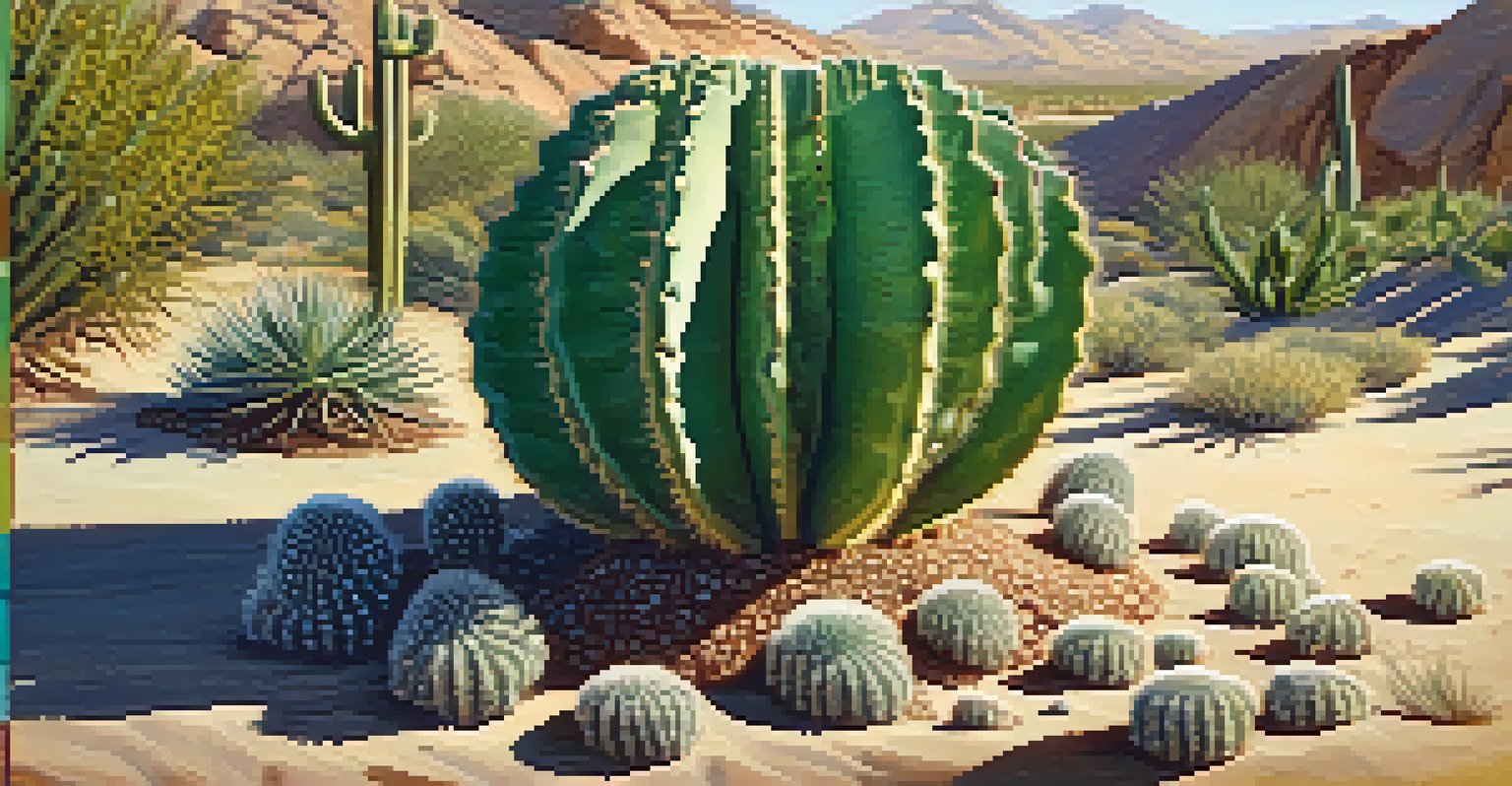Peyote's Role in Ancestral Connection Among Indigenous Cultures

Understanding Peyote: A Sacred Cactus
Peyote, a small, spineless cactus native to Mexico and the southwestern United States, has long been revered for its psychoactive properties. It contains mescaline, a compound that induces altered states of consciousness, often leading to profound spiritual experiences. For many Indigenous cultures, peyote is not just a plant; it embodies deep spiritual significance and connection to their ancestors.
Psychedelics have the potential to heal and transform, but they must be approached with respect and understanding of their cultural significance.
Traditionally, peyote has been used in various ceremonies and rituals, particularly among Native American tribes. These gatherings are often centered around the peyote ceremony, where participants consume the cactus to seek visions, insights, and healing. This practice underscores the importance of peyote as a bridge between the physical and spiritual worlds, facilitating a connection to ancestors and the divine.
Furthermore, the use of peyote is deeply intertwined with Indigenous identity. It serves as a cultural touchstone, affirming ties to ancestral traditions and communal practices. As a result, peyote is not merely a substance; it is a vital element of cultural heritage and spiritual life for many Indigenous peoples.
Peyote in Ceremonial Practices
The peyote ceremony is a time-honored tradition that varies among different Indigenous groups, but some elements remain consistent. Participants gather in a circle, often led by a knowledgeable guide, or 'roadman,' who directs the ceremony. The atmosphere is one of reverence, with songs, prayers, and storytelling, all of which enhance the spiritual experience of consuming peyote.

During the ceremony, participants often share personal stories and experiences, fostering a sense of community and belonging. This collective sharing not only reinforces social bonds but also serves as a way to honor ancestors, as stories often include lessons or wisdom passed down through generations. Each ceremony becomes a living history, where ancestral connections are celebrated and kept alive.
Peyote's Cultural Significance
Peyote serves as a vital element of cultural heritage and spiritual life for many Indigenous peoples, reinforcing their connection to ancestors and traditions.
Moreover, the ceremonial use of peyote offers a space for healing, both physical and emotional. Many attendees report transformative experiences that yield insights into their lives and ancestral lineage. This healing aspect underscores the belief that peyote holds the power to connect individuals to their roots and promote overall well-being.
The Spiritual Journey of Peyote Users
For those who partake in peyote ceremonies, the experience is often described as a journey into the self, guided by the visions that arise. These visions can vary widely, from encountering ancestors to receiving messages about life’s purpose. Such experiences create a profound sense of interconnectedness with the universe and one’s lineage.
The use of peyote is not just about the substance; it’s about the connection to culture, identity, and history.
As participants navigate their spiritual journeys, they often find clarity and understanding about their place in the world. The insights gained can lead to personal growth, prompting individuals to reflect on their actions and relationships. This transformative journey is seen as a rite of passage, linking the present to the past.
Many users of peyote return to their communities with renewed strength and perspective, eager to share their experiences. This sharing is crucial, as it perpetuates the cycle of knowledge and connection among community members, ensuring that ancestral wisdom continues to thrive.
Peyote and Indigenous Identity
Peyote plays a critical role in shaping Indigenous identity, reinforcing cultural values and collective memory. For many tribes, the use of peyote is a declaration of cultural resilience, a way to assert their identity in the face of historical oppression. This aspect of peyote usage fosters pride among Indigenous peoples and strengthens community ties.
Furthermore, the resurgence of interest in traditional practices, including peyote ceremonies, reflects a broader movement toward cultural revitalization. Younger generations are increasingly seeking to reconnect with their roots, and peyote serves as a conduit for this exploration. By participating in these ceremonies, they not only honor their ancestors but also forge a path toward a more profound understanding of their heritage.
Healing Through Peyote Ceremonies
Peyote ceremonies provide a powerful space for personal and communal healing, fostering resilience and insights that empower participants.
This connection to identity is particularly important in a contemporary context, where Indigenous peoples are often navigating the challenges of modern life. Peyote provides a means to reconnect with culture and history, creating a sense of belonging and purpose amidst changing societal landscapes.
Legal and Ethical Considerations of Peyote Use
The use of peyote is legally protected for some Indigenous groups in the United States, particularly those involved in the Native American Church. This legal recognition acknowledges the spiritual significance of peyote and its role in cultural practices. However, the legality of peyote use is not universal and can vary significantly, raising important ethical questions about accessibility and cultural appropriation.
As interest in peyote grows, particularly among non-Indigenous individuals, concerns about cultural appropriation arise. It is essential to respect the traditions and significance of peyote within Indigenous cultures, rather than commodifying it. Ethical engagement requires understanding and honoring the historical context of these practices and ensuring that Indigenous voices are prioritized in discussions about peyote.
Moreover, the sustainability of peyote harvesting is a pressing issue. With rising demand, there is a risk that overharvesting could threaten the cactus’s survival. It is crucial for both Indigenous communities and broader society to advocate for sustainable practices that honor the land and the traditions associated with peyote use.
The Role of Peyote in Healing Practices
Peyote is often viewed as a powerful tool for healing within Indigenous cultures. The ceremony provides a safe space for individuals to confront personal challenges, traumas, and emotional pain. Participants often report feelings of catharsis and renewal, stemming from their peyote experiences, which encompass both individual and communal aspects of healing.
The healing properties of peyote extend beyond the individual. As participants share their experiences, they reinforce community bonds, creating an environment of support and understanding. This collective healing process fosters resilience and empowers individuals to navigate their lives more effectively, armed with the insights gained during the ceremonies.
Legal and Ethical Challenges
The use of peyote raises important legal and ethical questions regarding accessibility, cultural appropriation, and the sustainability of its harvesting.
Moreover, traditional healers often incorporate peyote into their practices, utilizing it as a means to diagnose and treat physical and spiritual ailments. This holistic approach to healing emphasizes the interconnectedness of mind, body, and spirit, reflecting a worldview that prioritizes balance and harmony.
Peyote's Future: Challenges and Opportunities
As society evolves, the future of peyote in Indigenous cultures faces both challenges and opportunities. On one hand, increasing interest in traditional practices presents a chance for cultural revitalization and education. On the other hand, it raises concerns about appropriation and sustainability, necessitating careful navigation of these dynamics.
Advocacy for Indigenous rights and the protection of peyote’s sacred status is imperative. By supporting Indigenous-led initiatives, society can help ensure that peyote remains a vital part of cultural identity without compromising its integrity. This collaboration can empower Indigenous communities to control the narrative around peyote and its use.

Ultimately, the future of peyote lies in a balance between honoring its ancestral significance and adapting to contemporary realities. By fostering respectful relationships and understanding, both Indigenous and non-Indigenous peoples can work towards a future where peyote continues to be celebrated as a sacred and transformative element of life.